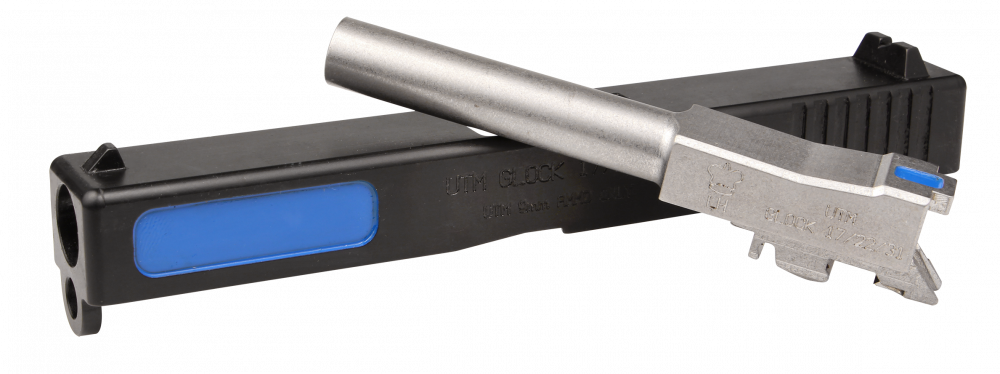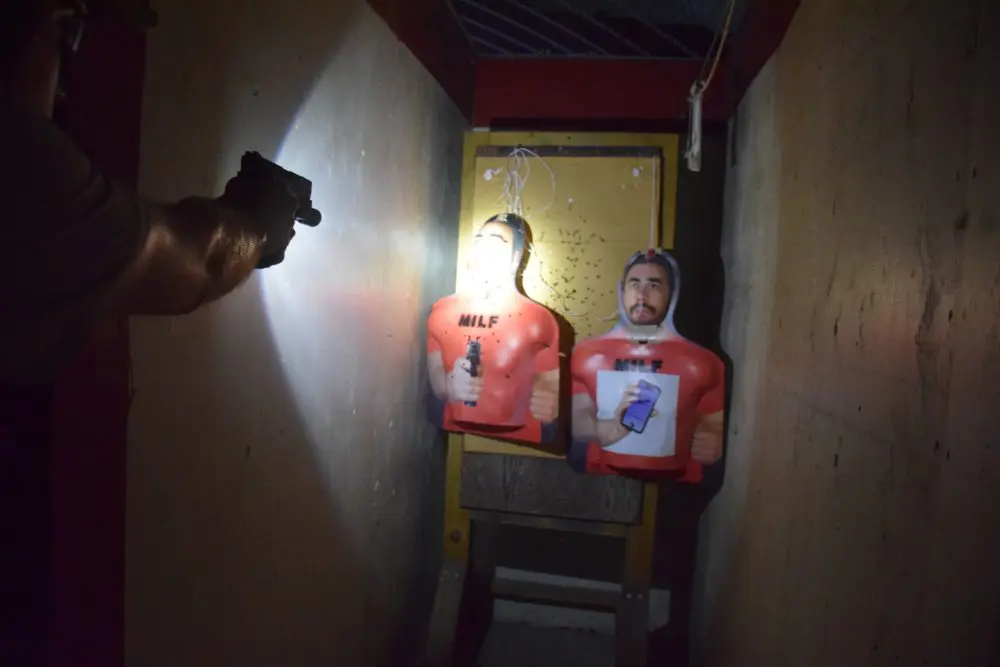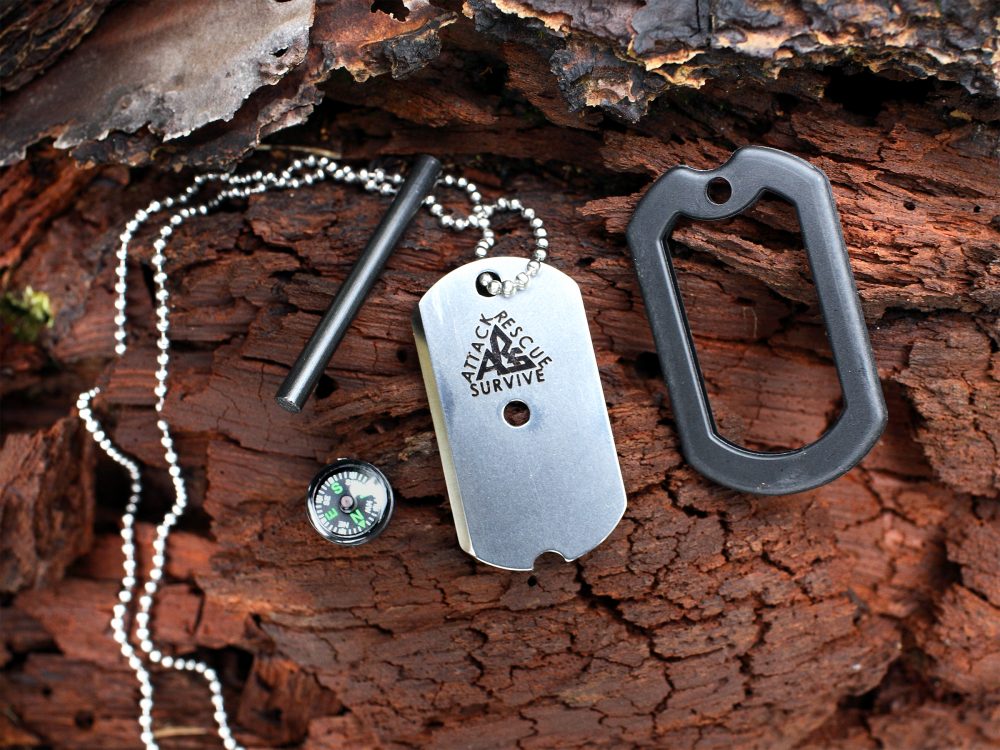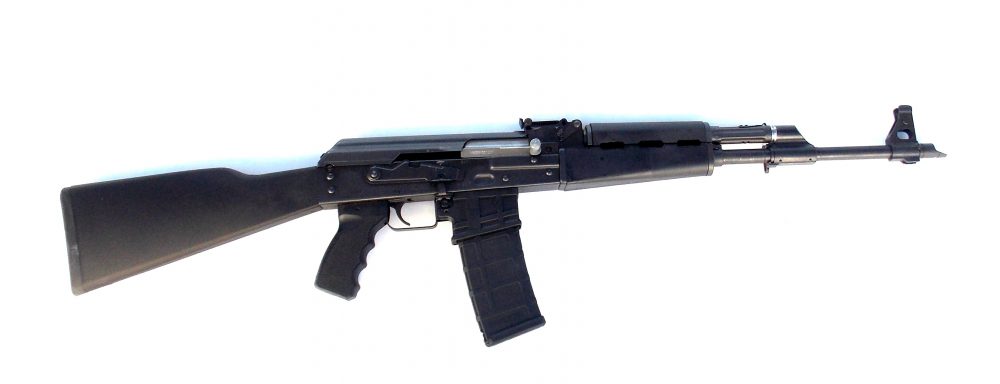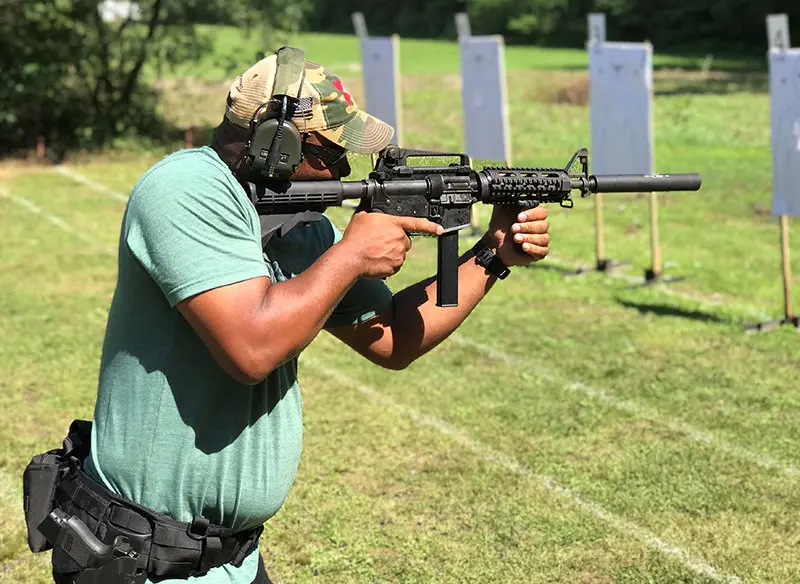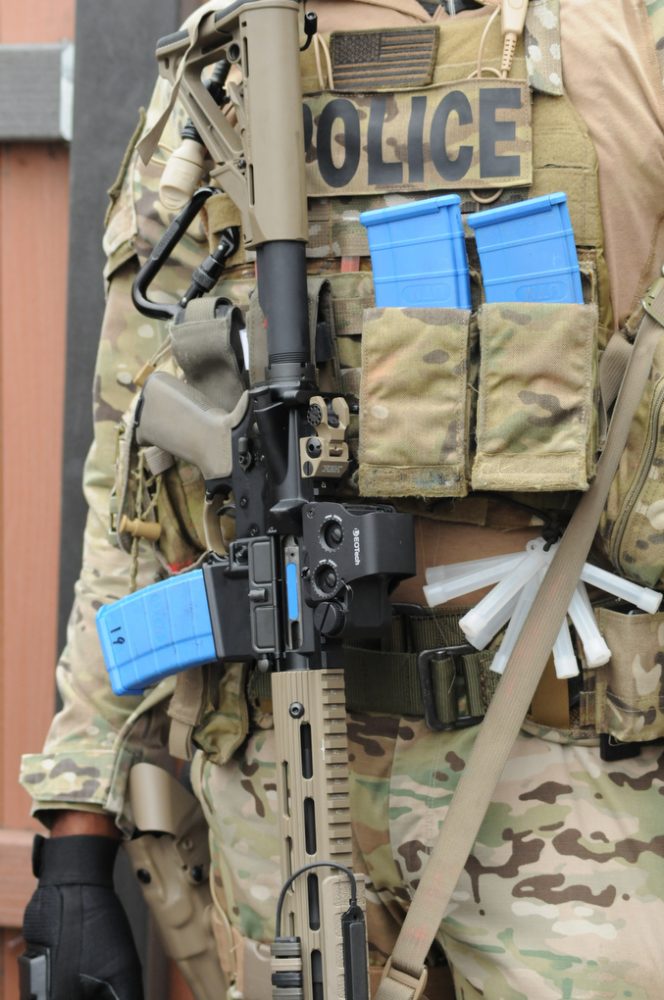
Ultimate Training Munitions (UTM) makes a wide variety of live-fire simulation training ammunition. This includes non-lethal training ammo, shoot-house ammo, blanks and defensive tactics loads, handgun and rifle conversion kits, protective apparel, training props, and training magazines. UTM munitions are used in 57 countries throughout the world, including both the U.K. and the U.S. The largest U.S. customer is the military, buying 45 million rounds per year.The best way to get a complete picture of this force-on-force training ammo is to do what we did: attend one of the dozens of Non-Lethal Training Ammunition (NLTA) instructor certification courses put on by UTM.
Table of Contents
WIDE VARIETY OF MUNITIONS
UTM is best known for their Man Marker Round (MMR). These traditional marking cartridges are available in red, blue, green, and yellow. The MMR is the clear choice for reliable and realistic force-on-force training.
In addition to the marking rounds, UTM training munitions include the Silent Blank Round (SBR), Battlefield Blank Round (BBR), Target Bullet Rounds (TBR), Loud Blank Round (LBR), and Reduced Velocity Round (RVR).
The SBR uses only a primer to cycle the gun but does not fire a projectile and does not produce any noise. It is intended for close-range defensive tactics and disarm training. The BBR is noise only. It uses two primers, one to cycle the gun and one as a noisemaker. You still need eye protection but not ear protection.
SHOOT-HOUSE AMMO
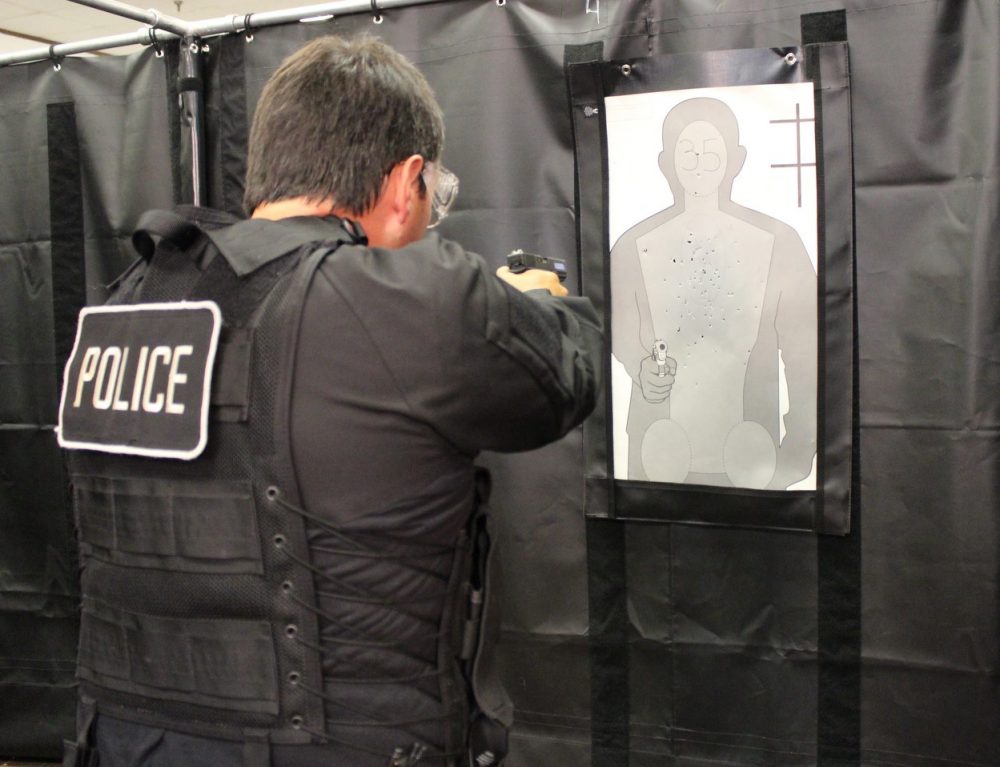
The exceptions in the UTM lineup are the TBRs in 9mm and 5.56mm. Of all the UTM munitions, the TBR fires a potentially lethal projectile, a 6.6-grain aluminum projectile. These are not force-on-force rounds but are designed to be used in live-fire shoot houses.In these houses, live-fire ammo tears up both used tires and wooden railroad ties. The solution is the TBR, which allows the entire shoot house to be made up of just ¾-inch plywood. Use of the TBR also permits the use of rifles in a shoot house made from handgun-rated AR500 steel, which is much less expensive than rifle-rated AR550 steel.
Since this is such a different project in UTM’s training munitions line, special measures are taken. A special separate bolt is required. Since the primer is recessed into the case, a longer firing pin is also required. The TBR bolt has this longer firing pin.
DUAL PRIMER SYSTEM
The dual primer system used by UTM munitions sets them apart from all other less-lethal munitions. The UTM cartridges are built with a rear primer and a separate front primer. The weapon’s firing pin strikes the rear primer. When it goes off, a round firing-pin ball is driven into the front primer, which ignites and propels the bullet. It is this dual primer system that gives UTM ammo the clear advantages of both cycle reliability and accuracy.
With UTM munitions, the energy needed to cycle the gun is totally separated from the energy needed to propel the bullet. The primer with the right amount of power for cycle reliability is used independently of the primer with the right amount of power for the desired bullet velocity. The result is optimized weapon reliability and optimized accuracy and range.
The rear primer is either a Blank cartridge (rifle) or Boxer primer (handgun). This primer produces the energy to cycle the gun and launch the self-contained firing ball to ignite the front primer. All the front primers are the traditional Boxer design, which launches the bullet. Importantly, the marking projectile is powered by the front primer only, not by the rear Blank cartridge or rear primer.
This dual primer design means UTM munitions are the most reliable non-lethal training rounds. Anyone experienced with training rounds knows that weapon function is a huge problem. UTM munitions solve that cycling problem. In fact, the cycle reliability of UTM munitions rivals that of factory loaded live ammo. Based on a two-year study by Picatinny Arsenal, UTM munitions have a 99.8% reliability rating.
The biggest difference among all the UTM Rounds is the rear primer used to cycle the firearm normally. UTM handgun cartridges and rifle cartridges are similar in design. In handgun versions, both the front and rear primers are traditional Boxer primers.
ACCURACY

Along with fewer malfunctions than traditional less-lethal training munitions, UTM munitions are also more consistent and more accurate. UTM munitions group into two inches or better at 25 yards. That is live-ammo levels of accuracy and far more accurate than any other brand or kind of non-lethal training munitions on the market. One reason is the two-primer system, and the other reason is the driving band on the bullet.On military UTM munitions, the driving band is aluminum. On UTM law enforcement (black) munitions, the driving band is Teflon®. The military aluminum driving band has some advantages, but has the disadvantage of leaving scratches on vehicles it impacts. So the law enforcement round uses the Teflon driving band. Better rifling engagement with the Teflon driving band also results in better accuracy.
Unlike many non-lethal training munitions, with UTM munitions no plastic from the projectile touches the lands and grooves of the rifling. That means less plastic ribbon debris in the rifling, which allows weapon cleaning to be less frequent. Recommended cleaning interval is every 900 to 1,000 rounds. Compare that to whatever non-lethal training ammo you are currently using.
MARKING COMPOUND
In most cases, the marking compound is a non-toxic, inert, wax-based compound that comes in four standard colors. One of the 5.56mm MMR versions and one of the 9mm MMR versions use a non-toxic, inert, water-soluble compound, also in red, blue, green, and yellow.
UTM bullets have a real advantage over other non-lethal training bullets. Other bullets need to burst or break to leave their marking. The munition may hit but not mark the target. UTM bullets mark through inertia. On impact, a small steel ball behind the wax continues to move forward, pushing the wax through the cruciform dome.
The inertia applicator ball adds weight to the projectile and pushes the wax out but remains trapped in the projectile. The cruciform dome remains intact during impact, i.e., it does not break and does not need to break. UTM projectiles mark at any impact angle, including glancing hits, and do not have to burst to mark. Range apparel and personal protective equipment (PPE) can be cleaned with any laundry detergent to wash the wax out.
SIMUNITION-COMPATIBLE 9MM UTX
Glock 17, 22, and 31 conversion kit. UTM makes over 150 different pistol conversions to fit their training ammo. With UTM conversions, simply swap out slide and barrel.
You cannot use either Simunition® FX or ATK Force-on-Force™ ammo in a UTM converted firearm. But in a reversal, at the 2016 SHOT Show, UTM introduced their 9mm UTX non-lethal ammo. The 9mm UTX can be used anywhere the 9mm Simunition is used from an FX conversion. UTM ammo has better cycle reliability and is less expensive.
The 9mm UTX bullet weighs 8.0 grains instead of the normal 6.9 grains and has a muzzle velocity of 370 fps, compared to a muzzle velocity of 460 fps for the Simunition FX bullet.
In this setup, the UTX bullet will be as accurate as the Simunition bullet out to 15 yards, but not as accurate beyond that. The accuracy of the 9mm Man Marker Round (MMR) and 9mm Target Bullet Round (TBR) through a UTM conversion is two inches at 11 yards. In comparison, the accuracy of the UTM 9mm UTX Round through a Simunition conversion is three inches at eight yards.
EFFECTIVE RANGE AND STANDOFF DISTANCES
UTM identifies two training distances: optimum effective range and maximum effective range. The 9mm MMR and 5.56mm Reduced Velocity Round (RVR) have an optimum range of 11 yards and a maximum range of 22 yards.
The 9mm UTX (Simunition-compatible) ammo has an optimum range of eight yards and a maximum range of 27 yards. The 5.56mm and both of the 7.62mm MMRs have an optimum range around 30 yards and a maximum range around 50 yards.
Less-lethal and non-lethal training munitions are all about the minimum standoff distance. The rule for MMRs and Simunition-compatible UTX Rounds is a standoff distance of 12 to 18 inches. That means no contact shots.
For rifle rounds, the 5.56mm, .308 Win, and AK 7.62x39mm MMRs have a standoff distance of three feet, while the 5.56mm RVR has a standoff distance of 18 inches. With a shorter standoff distance, the role of the RVR in force-on-force training is clear.
The Target Bullet Round (TBR) in all calibers does not have a safe standoff distance. The TBR should not be fired at anyone regardless of the distance.
SHOOTING IMPRESSIONS
All UTM instructor courses involve range time with a variety of munitions from a variety of firearms. We fired MMRs from a converted Glock and a converted S&W M&P. We also fired the TBR from a converted Colt M4. All UTM munitions cycled perfectly and gave the expected accuracy.
The highlight of the range time was shooting the 9mm UTX from a Glock 22 with a Simunition blue slide and gold barrel. Lots of Simunition conversions are in police inventories, and the UTX ammo totally solves nagging cycle reliability problems.
Lieutenant Ed Sanow is director of training with the Benton County, Indiana Sheriff’s Department and co-author of three ammo stopping power books. He can be reached at LtEdSanow@gmail.com.
SOURCE:
ULTIMATE TRAINING MUNITIONS
(908) 725-9000
www.utmusa.com

